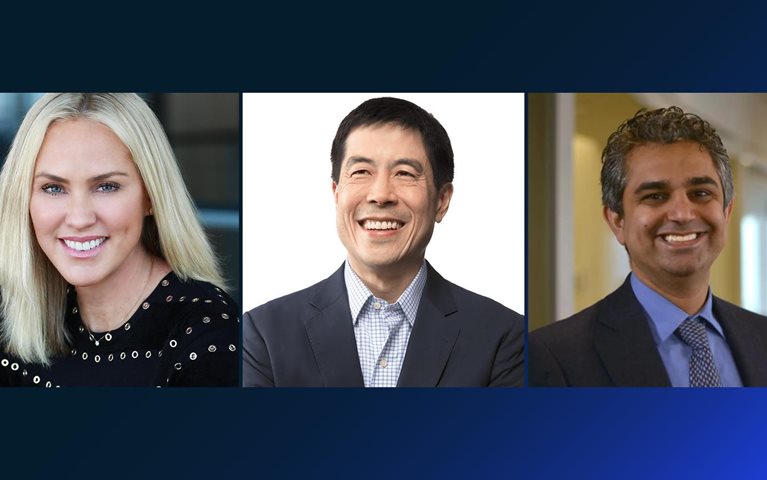The McKinsey Technology Council—a global group of over 100 scientists, entrepreneurs, researchers, and business leaders—has published its second annual Technology Trends Outlook. By assessing metrics of innovation, interest, investment, and adoption, the council has prioritized and synthesized 40 technologies into 14 leading trends.
Following on from last year, applied AI once again earned the highest score for innovation in the report. Sustainability, meanwhile, emerged as a major catalyst for tech around the world, with clean energy and sustainable consumption drawing the highest investment from private-equity and venture-capital firms. And five new trends were added to this year’s edition: industrializing machine learning, Web3, immersive-reality technologies, the future of mobility, and the future of space.
In this post, McKinsey senior partner Lareina Yee, expert partner Roger Roberts, and McKinsey Global Institute partner Michael Chui share their thoughts about what the findings may mean for leaders over the next few years.

There are a number of tech trend reports published each year. What’s unique about this one?
Lareina: It provides a bird’s eye view of the full spectrum of technology trends, from the bio revolution to advanced connectivity to space exploration. It also shows how all of these trends are threading together so leaders can understand the opportunities they create.
For example, the metaverse is not a single trend but includes cloud computing, advanced connectivity, applied AI, and also immersive reality technologies and Web3, all of which allow for the creation of truly new experiences and modes of interaction. What this means is that creativity—how these technologies can be used together—may be the ‘constraining’ resource now, more than just computing or storage or network bandwidth.
What surprised you most about the findings?
Roger: One thing that I think is under appreciated is the potential in next-generation software development, the tools and capabilities which allow software developers to better write, develop, and test code faster and to therefore innovate in much quicker timeframes. That has huge power, so if I looked at which of these trends that people should be pushing faster and harder, that would be one. Also, over the next year or two, I think we’re going to see a lot more clarity emerging about the potential impact of quantum computing, which has been moving from science to engineering and will start to really scale in certain use cases.
Michael: I am excited about the huge leap forward that industrializing machine learning (a form of AI) has taken, even over the past year, moving from pilots into production scale for real-world business use. Machine learning has an incredible variety of applications, creating value across multiple sectors. Some examples include predicting when customers are at risk of “churning” and dropping a service, identifying potential financial fraud more accurately, and assuring autonomous vehicles can navigate the streets of our cities safely.
What should business leaders take away from this tech report?
Roger: If a company can better understand those technologies which have the most momentum—by which we mean research, venture funding, use-case development—they can identify those that they need to act on in the next several years, and those for which they can take on a posture of watchful waiting.
In practical terms this means thinking about, “What tech curves am I going to ride here and then what curves am I going to try to bend?” And by “riding,” I mean utilizing outside R&D and talent and letting that lift my business. On the “bending” side, leaders would say, “I’m putting my own engineering muscle behind thinking about how to shape something to our needs or build something unique on top of these platforms.” That’s where the combination of creativity, design, engineering, and data science need to come together at the front lines to build a new consumer experience or to launch that new business.
Lareina: Companies also need to think about how these tech initiatives might shape the partnerships or alliances of their ecosystem. We know that companies with stronger networks of relationships will be better positioned to win in the world that’s being reinvented by these technologies.

McKinsey Technology Trends Outlook 2022
How will this research shape the work McKinsey does with its clients?
Lareina: We’re sharing the findings and partnering with industries to think through how specific trends can best help companies achieve sustainable and inclusive growth. Some examples of this include: identifying opportunities for consumer brands to develop beauty products with biodegradable ingredients; exploring the ways that advanced connectivity can extend healthcare and education services for more inclusive access; and looking at how immersive tech can deepen training and product support, so manufacturers can enhance customer and employee experiences together.
Any predictions for next year?
Michael: From year to year, the names of the trends aren’t going to shift so much. But the level of investment, the way in which they’re being applied, the rate of transition from science to engineering to practice will change. I’d love to see enterprises employing the engineering and also using their talents in creativity, design, and organizational change to combine and apply these technologies in new and unexpected ways.
Roger: I would highlight that it’s not just what the tech trends are, but how fast they are moving that is really extraordinary. We have seen this during the pandemic with the unprecedented pace of development and delivery of mRNA vaccines. This happened at a rate that many experienced people did not think would be possible. It shows that there are a range of players—governmental, environmental, technological—combining to accelerate technology change on many dimensions. Leaders need to prepare to move at this pace.

